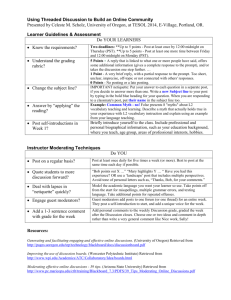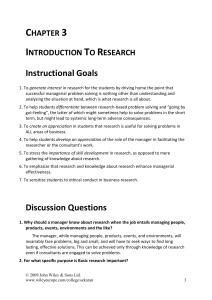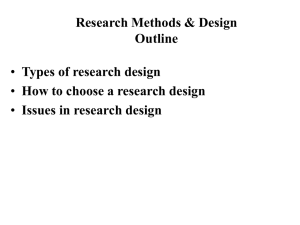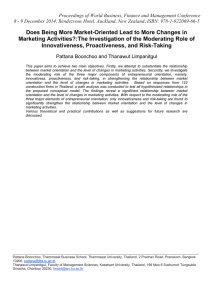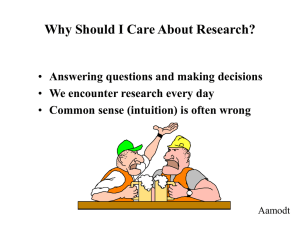Theoretical Framework - Research-Seminar-II
advertisement
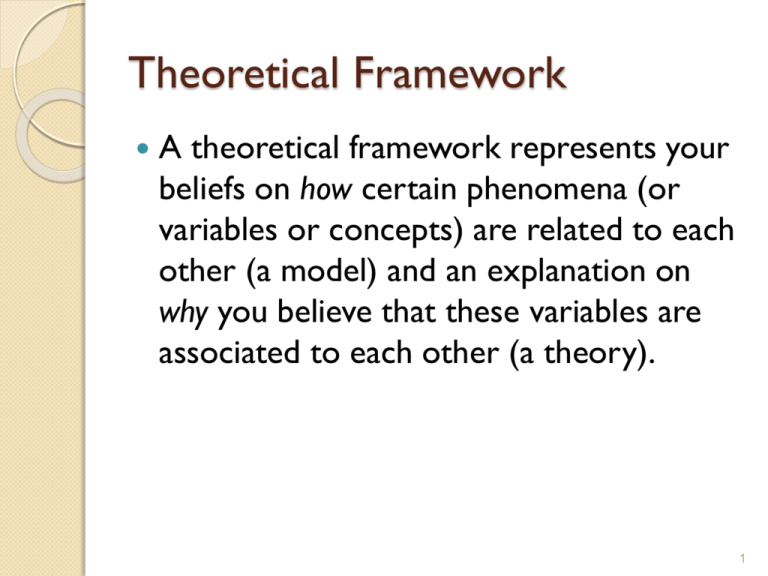
Theoretical Framework A theoretical framework represents your beliefs on how certain phenomena (or variables or concepts) are related to each other (a model) and an explanation on why you believe that these variables are associated to each other (a theory). 1 Theoretical Framework Basic steps: ◦ ◦ ◦ Identify and label the variables correctly State the relationships among the variables: formulate hypotheses Explain how or why you expect these relationships 2 Variables Any concept or construct that varies or changes in value Main types of variables: ◦ ◦ ◦ ◦ Dependent variable Independent variable Moderating variable Mediating variable (or intervening) 3 (In)dependent Variables Dependent variable (DV) ◦ Is of primary interest to the researcher. The goal of the research project is to understand, predict or explain the variability of this variable. Independent variable (IV) ◦ Influences the DV in either positive or negative way. The variance in the DV is accounted for by the IV. 4 Examples List the variables, and label them as dependent or independent, explaining why they are so labeled. Example 1 An applied researcher wants to increase the performance of organizational members in particular bank. 5 Answer to Example 1 The dependent variable is organizational performance because it is the primary variable of interest to the applied researcher, who wants to increase the commitment of the members in the bank. 6 Example 2 A marketing manager wonders why the recent advertisement strategy does not work. What would be the dependent variable here? Answer: 7 Example 3 Research studies indicate that successful new product development has an influence on the stock market price of the company. That is, the more successful the new product turns out to be, the higher will be the stock market price of the firm. 8 Answer to the Example 3 Independent Variable… Dependent Variable… 9 Example 4 Cross-cultural research indicates that managerial values govern the power distance between superiors and subordinates. Dependent V. : Independent V. : 10 Example 5 A manager believes that good supervision and training would increase the production level of the workers. Answer Dependent V.: Independent V.: 11 Example 6 A consultant is of the opinion that much benefit would accrue by buying and selling at the appropriate times in a financial environment where the stocks are volatile. Answer Dependent V.: Independent V.: 12 Example 7 It has been found that there is a relationship between the availability of Reference Manuals that manufacturing employees have access to, and the product rejects. That is, when workers follow the procedures laid down in the manual, they are able to manufacture products that are flawless. 13 Answer to Example 7 Dependent Variable: Independent Variable: 14 Example 7 (Cont.) Although this relationship is true in general for all workers, but it is not true for workers who are not using the manual every time they need it. Thus, the interest and inclination of the workers is a Moderating Variable. ( See Figure 3B) 15 Figure 3B Copyright © 2003 John Wiley & Sons, Inc. Sekaran/RESEARCH 4E FIGURE 5.3b 16 Moderators Moderating variable Moderator is qualitative (e.g., gender, race, class) or quantitative (e.g., level of reward) variable that affects the direction and/or strength of relation between independent and dependent variable. 17 17 The Moderating Variable Is one that has a strong contingent effect on the independent variabledependent variable relationship. The presence of the moderating variable modifies the original relationship between the independent and dependent variables. 18 Example 8 A prevalent theory is that the diversity of the workforce (according to different ethnic origins, races, and nationalities) contributes more to organizational effectiveness because each group brings it own special expertise and skills to the workplace. This synergy can be exploited, however, only if managers know how to harness the special talents of the diverse work group; otherwise, they will remain untapped. (See Figure 4) 19 Figure 4 Copyright © 2003 John Wiley & Sons, Inc. Sekaran/RESEARCH 4E FIGURE 5.4 20 Distinction Between Variables Situation 1: A research study indicates that the better the quality of the training programs in an organization and the greater the growth needs of the employees ( where the need to develop and grow on the job is strong), the greater is their willingness to learn new ways of doing things. 21 The dependent variable: the employees willingness to learn. The independent variables: the training programs and growth need strength. ( See Figure 5A) 22 Figure 5A Copyright © 2003 John Wiley & Sons, Inc. Sekaran/RESEARCH 4E FIGURE 5.5a 23 Situation 2 Another research study indicates that the willingness of the employees to learn new ways of doing things is not influenced by the quality of the training programs offered by the organizations to all people without any distinction. Only those with high growth needs seem to have the yearning to learn to do new things through specialized training. 24 The dependent variable in this case is the employees willingness to learn. The independent variable is the quality of the training program. The moderating variable: … 25


